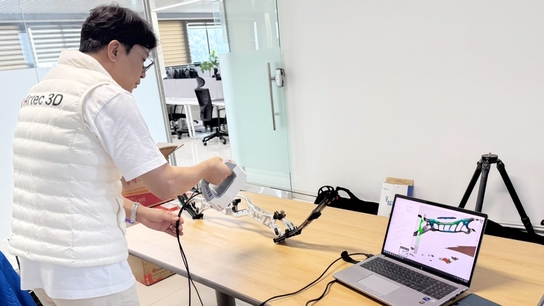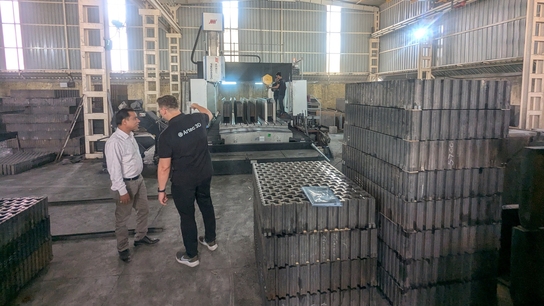Bringing an Italian 14th century bronze masterpiece back to life with Artec Spider
Challenge: A high-profile cultural preservation project called for the use of a 3D scanner to digitally capture a 680-year-old set of bronze doors for the purpose of creating exact replicas for public exhibit.
Solution: Artec Spider, Artec Studio, ZBrush, Meshmixer
Results: A pair of giant bronze doors was captured in minute detail with a professional handheld 3D scanner. The scans were turned into high-resolution 3D models, which were then 3D printed as panels for use in a lost wax casting process to create the final replicas.
As Italian goldsmith, sculptor, and architect Andrea Pisano put the finishing touches on the ornate bronze doors he created for the Baptistery of the Florence Cathedral in 1336, only twelve years remained until the Black Death would strike Italy from the sea and begin its devastating march across Europe. The population of Florence wouldn’t fully recover for another 500 years. But in the decades prior, there was much for the local citizens, artists, and merchants to celebrate.

Andrea Pisano’s bronze doors, standing and being scanned with Artec Spider
Dante and several other well-known Renaissance figures had been baptized in the cathedral’s baptistery, said to have been first erected in the late fourth or early fifth century AD. Although it wasn’t until the year 1329 that Florence’s powerful and influential Cloth Merchants Guild, responsible for taking care of the baptistery, decided to replace the existing wooden door with bronze doors.
Andrea Pisano was awarded the honor of designing what were to become the baptistery’s first pair of doors, initially installed on the east side of the building, yet later moved to the south side.

The Florence Baptistery, interior and exterior views
When Pisano finally unveiled the towering cast bronze doors, they quickly became the pride of Florence. Their 28 intricately carved relief panels with various geometric patterns and shapes as well as 20 scenes from the life of John the Baptist captivated the imagination of countless citizens and religious pilgrims.
Yet in the 680 years since the massive, 8-ton doors were first erected, they had suffered significant deterioration due to weather and pollution. As well, over the centuries a buildup of unstable salts was slowly eating away at the bronze, destroying the very artwork itself.
As part of a cultural preservation project sponsored by the Opera di Santa Maria del Fiore, it was decided to replace Pisano’s doors with exact replicas. The baptistery’s other two sets of doors, those for the east and north sides of the building, had been replaced years earlier. Now all that remained were Pisano’s.
For accomplishing this multiphase endeavor, the Opera partnered with the Frilli Gallery, a leading Florence art studio famous across Italy and around the world for its impeccable standards of artistic mastery. From beginning to end, the Frilli Gallery fastidiously coordinated the efforts of dozens of skilled specialists.
The restoration project began in 2016 and took 3 years to complete. The east and north doors had plaster casts, which made it possible for duplicates to be made, but Pisano’s south doors did not. Considering the complex surfaces of the doors and artwork and the need to recreate them as perfectly as possible, the restoration team decided to use 3D scanning for the project.
After careful research on qualified firms capable of handling such a project of immense cultural importance, they turned to the experienced specialists at Prototek, a 3D scanning/printing service provider in Valenza, Italy. With years of experience in digital capture, 3D design, and 3D production services, Prototek didn’t hesitate when they were asked to take part in this high-profile cultural preservation project.
In the words of Prototek COO Andrea Barchi, “We were honored to participate in this multi-stage project, as it carried a profound level of significance for the citizens of Florence and all of Italy. The degree of results we achieved, now visible to anyone walking by the new doors, attest to the quality of our work, and this is something we’re ready to offer any client, regardless of project size or complexity.”
Following the careful removal of the two giant doors (16.2 feet (4.94 meters) tall by 9.6 feet (2.95 meters) wide and weighing around 8 tons) from the baptistery, they were meticulously yet gently attended to by master restorers, repairing the damage and removing the oxidation built up down through the centuries. Day after day as the restorers toiled away, the original gilding and magnificent details of Pisano’s artistry began to emerge.

A pause in a 3D scanning session with Artec Spider
Then the 3D scanning began. Prototek chose the Artec Spider for digitally capturing each intricately crafted panel of Pisano’s bronze doors. In the words of Andrea Barchi, “The Artec Spider is a 3D scanner par excellence, one we’ve relied upon many times for our most crucial scanning jobs that demand the highest levels of precision and extremely lifelike digital capture. It’s so comfortable for us to use, with the results displayed in real time on the laptop screen. The Spider is so advanced that we could reverse engineer practically any small object with it, anything from a priceless cloisonné vase from the early Qing dynasty, all the way to small-scale turbofan components for a Rolls Royce Trent 500 engine, and countless objects in between.”

Performing a sweep scan of the original bronze panels with Artec Spider and Artec Studio (background)
From start to finish, the 3D scanning part of the project took just 10 days. During that time, all 28 of Pisano’s original panels were digitally captured in high-resolution color and transformed into breathtaking 3D models.
“We have used other 3D scanners that require a stand or tripod for them to scan, but because Spider is lightweight and handheld, this enabled our technician to comfortably maneuver around each panel and capture it quickly and easily. Spider’s clean scans plus its speed of capture kept the file size and processing times down to a minimum,” said Barchi.
Following the digital capture, the scans from Spider were processed in Artec Studio. “Our scanning technician simply processed the scans in Artec Studio software, which offers a variety of tools for 3D data editing…deleting any unwanted data, aligning and registering the scans, and finally exporting them as 3D models ready for ZBrush as well as Meshmixer, which we used for working more closely with the panels’ intricate details and complex geometries,” said Barchi. “And in the case of ZBrush, we used it to rebuild some missing details in a few of the panels.”

Preparing to capture every intricate detail of the panels from all required angles with Artec Spider
The 3D models were then sent for 3D printing as 500mm x 500mm positive panels in PA12 on a 3D Systems sPro 230 SLS (Selective Laser Sintering) printer. After the panels were ready, they were sent to the Ciglia & Carrai Artistic Foundry, which created negative silicone molds from the positive panels. These negative molds were then used for casting the final bronze replicas via lost wax casting.

Prototek’s Andrea Barchi with a positive PA12 panel, ready for the negative silicone mold to be made
Once the casts had been poured and then fully cooled, Ciglia & Carrai’s artists and craftsmen went to work, gently refining and polishing the anatomical details, hands, feet, clothes, and other elements, faithfully bringing back to life all the lines and shapes and curves of Pisano’s original creation.

A specialist at Ciglia & Carrai putting the finishing touches on a bronze panel
Following the finishing, a final process was required, where acids were carefully poured across the surface of each bronze panel to naturally oxidize the metal and bring about an aged and authentic appearance to the masterpiece.
Once the panels were ready, it took one month before all the elements of the doors were assembled, ultimately achieving the final spectacular results.
At the installation ceremony, Florence’s citizens and visitors alike looked on in admiration and wonder at Pisano’s 14th century wonder reborn in the most elegant and exact way, thanks to 21st century technologies and the brilliant work of the specialists at Prototek and Ciglia & Carrai.

The thrilling moment at the unveiling ceremony when the crowd first saw the astonishing new doors
Today the replica doors have been restored to where the originals stood for centuries: on the south side of the Baptistery of the Florence Cathedral, where they will no doubt be gazed upon with admiration and curiosity for generations to come.
In regards to 3D scanning for cultural preservation tasks, Andrea Barchi commented, “Never before has technology been able to so fully meet the needs of museums and historical societies to help rescue our most precious historical artifacts and monuments. Here in Italy, and all across Europe, so many of these priceless creations of our ancestors are sadly falling into disrepair or even worse. But now these remarkable inheritances can be digitally captured and brought back to life using the latest in 3D scanning, such as the Artec Spider.”
Barchi continued, “What’s more, once these objects have been scanned and turned into 3D models, a museum can do some really creative things with them. For example, with Pisano’s doors, now they can be 3D printed in small scale, so museum visitors could have the chance to pick them up and hold them, or the 3D models could become part of a VR or AR exhibit, where visitors even on the other side of the world could walk right up and see these amazing doors up close and incredibly lifelike.”
Scanners behind the story
Try out the world's leading handheld 3D scanners.





